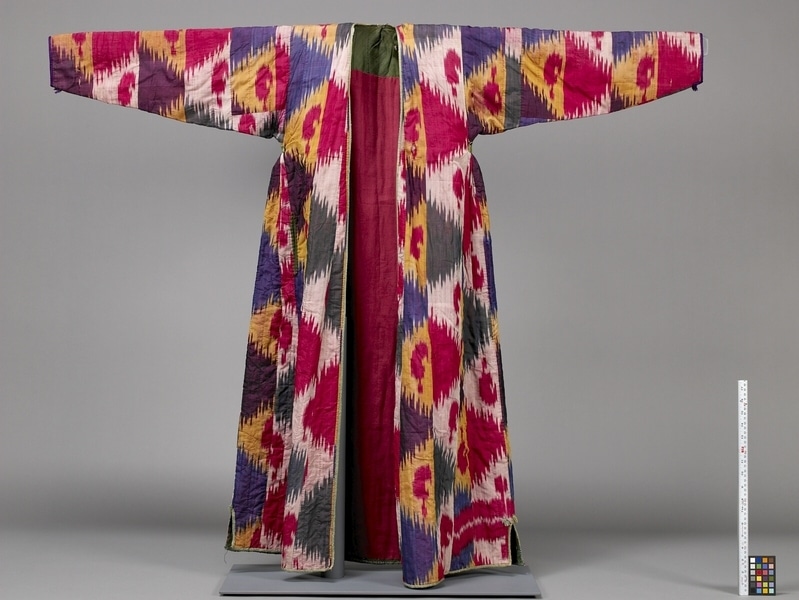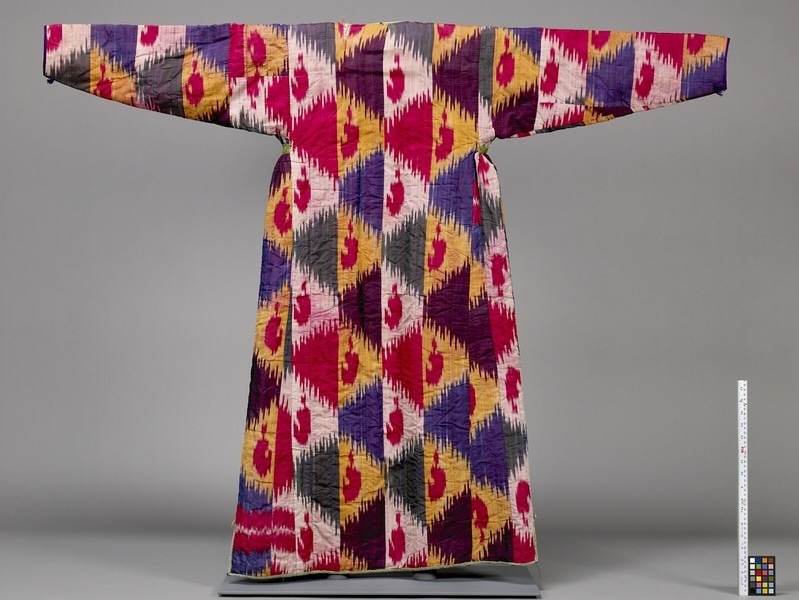Coat Item Number: 1065/1 from the MOA: University of British Columbia



Description
Woman’s silk taffeta multi-coloured ikat robe. The warp-dyed ikat textile is boldly patterned in red, yellow, blue, dark red and blue green on a pinkish white background; bright pink weft yarns give the garment an overall pinkish appearance. Collarless; wide v-neck; centre front overlaps from waist to hem; no closures; 9.5 cm slit at each side at the hemline. Gathering at the underarm is held in place with bright green embroidery, and the neck, front edges and hem are bound with narrow bright green woven binding. There is a welt pocket, bound in dark green cotton textile, in a seam on the right front. The sleeves are tapered to the wrist and are finished with purple woven binding. The body of the garment is quilted onto a lining of red cotton twill-weave textile; the centre-back shoulder area is lined with dark green cotton textile, which is also used to face the front edges; the sleeves are lined with multi-coloured cotton textile. There is a lightweight cotton batting between the silk and the lining.
History Of Use
Only individuals of high rank and social status could wear silk; the garments of lower ranking people could be made of textiles with silk warp, but cotton weft. In addition, the wide V-neck gives the wearer a space for displaying several chunky silver necklaces and brooches. Women were married in their robes, wore them for ceremonial occasions and were finally buried in them. The production of ikat silks, which reached its peak in the 19th C and declined rapidly in the early 20th C, was a commercial venture, carried out primarily in urban centers, such as Bukhara, Samarkand and Marghilan in the Ferghana Valley by various groups, such as Uzbeks, Turkmen and Tajiks. Woven silks were widely distributed throughout Central Asia and were sold in local bazaars. The varied tasks required in the complex dyeing and weaving of ikat textiles were traditionally assigned to specific ethnic groups. For instance, Jewish people were traditionally those who did the ‘cold dyeing’ with indigo. The cultivation of silk was women’s work, done in the home. Dyeing and weaving were done by men; women could not work outside the home. The lives of women centered around the home, where colourful, lavish textiles played a major role in the rituals of daily life. Men’s robes were made in the bazaar by the merchants who sold the textiles, while women’s robes were generally made by women in the home from textiles purchased from the market.
Narrative
The provenance of this piece is uncertain; it may have originated in either Uzekistan or Afghanistan, from an Uzbek, Turkmen or Tajik maker?
Item History
- Made in Uzbekistan ? during 1950
- Collected in Afghanistan ?
- Owned by Tradewind Antiques before November 14, 1985
- Received from Museum of Anthropology Shop Volunteers (Funding source) and Tradewind Antiques (Seller) on November 14, 1985
What
- Name
- Coat
- Identification Number
- 1065/1
- Type of Item
- coat
- Material
- silk fibre, dye and cotton fibre
- Manufacturing Technique
- warp dyed ikat, sewn, quilted and embroidered
- Overall
- height 120.0 cm, width 148.0 cm
Who
- Culture
- Uzbek ?
- Previous Owner
- Tradewind Antiques
- Received from
- Museum of Anthropology Shop Volunteers (Funding source) and Tradewind Antiques (Seller)
Where
- Holding Institution
- MOA: University of British Columbia
- Made in
- Uzbekistan ?
- Collected in
- Afghanistan ?
When
- Creation Date
- during 1950
- Ownership Date
- before November 14, 1985
- Acquisition Date
- on November 14, 1985
Other
- Item Classes
- textiles
- Condition
- good
- Accession Number
- 1065/0001